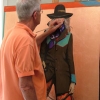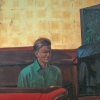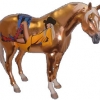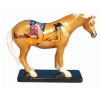
DeVary, David
Celebrating the Western Myth and the American Dream
David DeVary is the first to acknowledge that his paintings are not historically accurate depictions of cowboy life in the American West in the 1900s. "In actuality, cowboys led a rough, dangerous and anything-but-glamorous existence," he says.
The frontier that this artist explores draws more on the western movies of the '50s, starring matinee-idol cowboys like Roy Rogers and Gene Autry; his upbringing as a Catholic which "gave me the idea of creating modern icons of the figures we hold sacred"; and a highly successful, thirty-year career in the advertising business.
It helps to know his history....
David DeVary came to the painter's life rather late in life. He grew up in southern Illinois in the 1950s, the son of an uneducated sheet-metal worker whose mantra was "You don't want to be like me." But David idolized his father, to such an extent that when the senior DeVary would leave for work in the morning, his mother would strap David into a harness and hook him to a clothesline to keep him from following his dad.
Uneducated in the formal sense of the word, Lee DeVary, David's father, tried to make up for his lack of schooling by exposing his kids to "culture." When David showed an interest and talent in drawing at an early age, his father drove the family north to visit the Chicago Art Institute. It was a trip that would prove to be as formative as it was informative.
David's own formal education ended with high school, but his work history, which started before he graduated, set him on a career path. In the eighth grade he took a job in the art department of a local advertising agency, doing layout and design. At the age of nineteen he moved to the big city - Chicago - where he landed work at a publishing company doing keylines for $95 a week. Several turns at different Chicago advertising agencies led him to the hallowed halls of the prestigious J. Walter Thompson advertising firm, where his clients ranged from McDonalds and Pizza Hut to Hallmark cards and Kraft Foods, and his print advertisements and television commercials won him awards, including the New York Clio and the prestigious Gold Lion at the 1984 Cannes Film Festival.
David DeVary continued to scale the rungs of the corporate ladder, and soon became Creative Director and Senior Vice President of the Chicago office. By any measure his impressive accomplishments signaled great success. But there was another side to his success that was taking a toll personally. "To be honest, I was burnt out. I would get so upset before a client presentation that I would feel like a tightrope walker who'd lost his nerve."
Throughout his years in advertising David had painted in his spare time, showing his work in local galleries, attending classes at the Chicago Art Institute. And the senior DeVary had continued to encourage his son's artistic evolution. "I would call him up to boast about an important promotion or a big raise. All he'd respond was, "Are you still painting?'"
It was a scary step, but in 1989 he quit his job, sold his house, and moved with his wife and baby daughter to Santa Fe, New Mexico. To give Art a chance. It was in the midst of that first hectic month that his father passed away. "I didn't know how to mourn," David says. So he threw himself completely into his art, and his very first painting was of his father. "I had a photo of my dad as a young man standing in front of his Model T truck. I painted him like that and added gold leaf behind him, making an icon out of the picture. I called it 'Vanishing American.'" It was while contemplating that term - "Vanishing American" - that David found the subject matter he was meant to paint. "It dawned on me that cowboys were also vanishing Americans."
But rather than painting them realistically, riding the range or roping cows, David's vision was a highly romanticized one. "Cowboys are emblems of the American dream." As such, he decided to not paint history, but rather "to capture the good feelings associated with the way we thought about the West as children." In other words, to go to the opposite extreme of reality. To glorify and make cowboys look heroic. Moreover, he would place them against backgrounds that were used traditionally in religious paintings of saints: backgrounds of gold-, silver- and copper-leafing.
Once he started down the road of romancing the American West, it was almost a natural evolution to consider contemporary cowgirls as part of his subject matter. And given his commercial background, it was also natural for him to consider painting them in a style that harkened back to the years when he shared showroom space with Bill Blass and Lee Radziwell at a newly-remodeled Lord and Taylor on Fifth Avenue in New York: sleek of build and pretty as fashion models, wearing yellow slickers whipped by an imaginary wind, with big black cowboy hats tilted to hide their eyes, their body language exuding confidence and ATTITUDE.
Not everyone welcomed his portrayal. Some felt it presented a Hollywood stereotype rather than a real person. But to his way of thinking, they are missing the point. As an artist, he was not interested in painting the reality of a particular person. He wanted his paintings to have "a larger-than-life quality representing the embodiment of repressed wishes and the desires of modern society."
It should come as no surprise that when he was invited to be part of The Trail of Painted Ponies, several ideas came to mind. The one he liked most was the one that he eventually painted: a cowgirl who looks fresh from the runway, evocatively and provocatively reclining on the sides of an equally gorgeous Palamino pony, titled "Blondes."
Today, David DeVary is a member of a distinguished group of artists who are making a name for themselves as painters celebrating the romantic myths of the Old West with a bold new approach. He thinks of painting as "the last frontier," and welcomes projects such as The Trail of Painted Ponies as fresh ways to explore traditional themes in a contemporary fashion. His Painted Pony, "Blondes," has just been released as a collectible figurine.
Painted Pony figurines by David DeVary:
Additional Information
Where do you live?
Santa Fe, New Mexico. I’d seen some of Georgia O’keeffe’s paintings in the Chicago Art Institute and wondered why she’d left New York for Santa Fe. So I came out to see for myself and said, “Now I know why.”
How would you describe your artistic style?
Stylized and idealistic realism.
From where or who do you draw your inspiration for your art?
The myths of the American West.
What is your favorite movie?
What popped into my mind when you asked is “Petulia.” It starred George C. Scott and Julie Christie. He was a conservative doctor who fell in love with this crazy English bird, putting his marriage in jeopardy. But it wasn’t the plot that I liked so much as what Scott said in an interview. He said that when he takes on a role he usually knows what motivates a character, but this was a role in which he followed the script, but he had no idea who the character was he was playing.
Who is your hero?
My father. He was an uneducated sheet-metal worker with low self-esteem and he never thought of himself in that way and didn’t want me to think of him in that way. But I did and I do.
Favorite words of advice?
One word. Focus.





